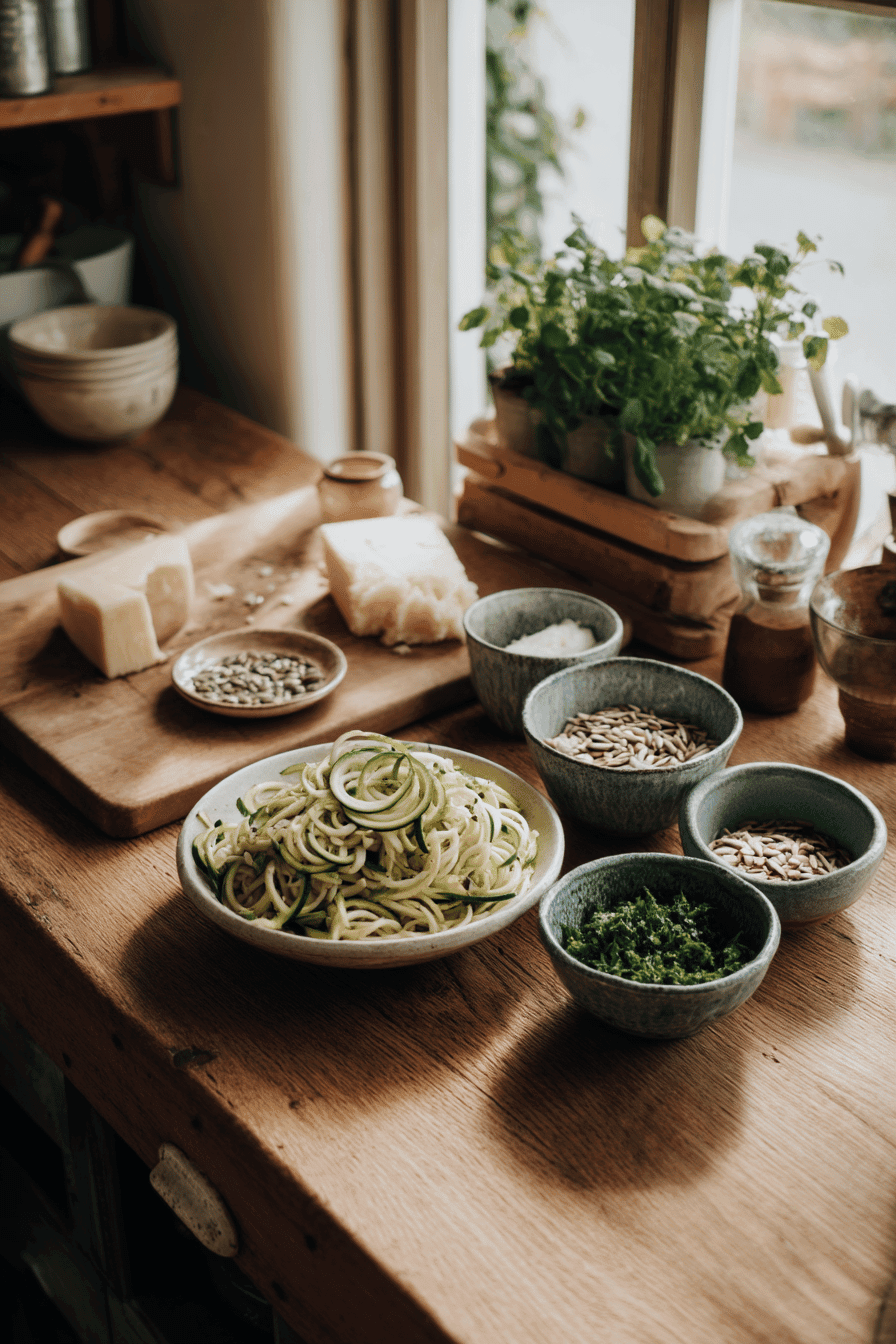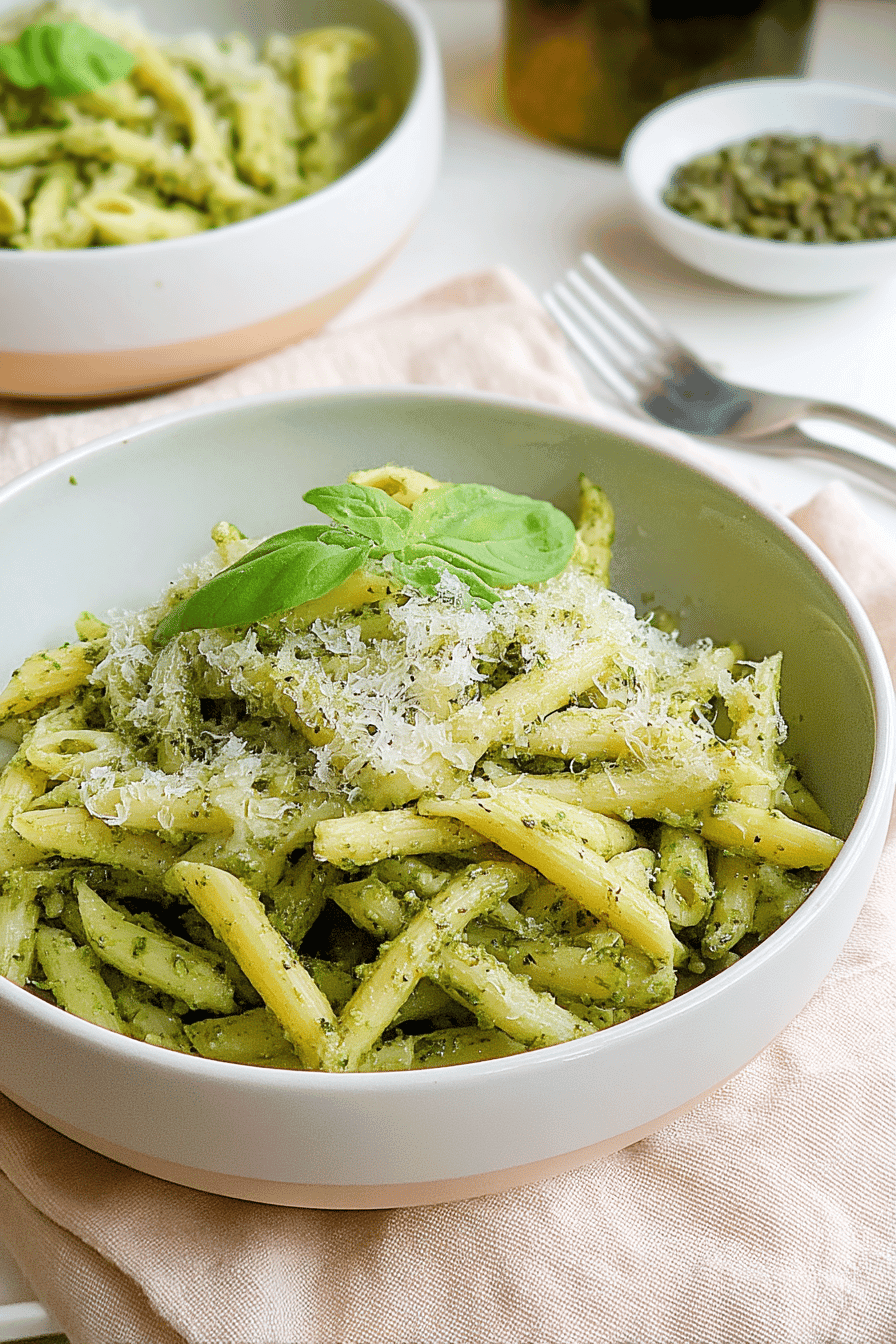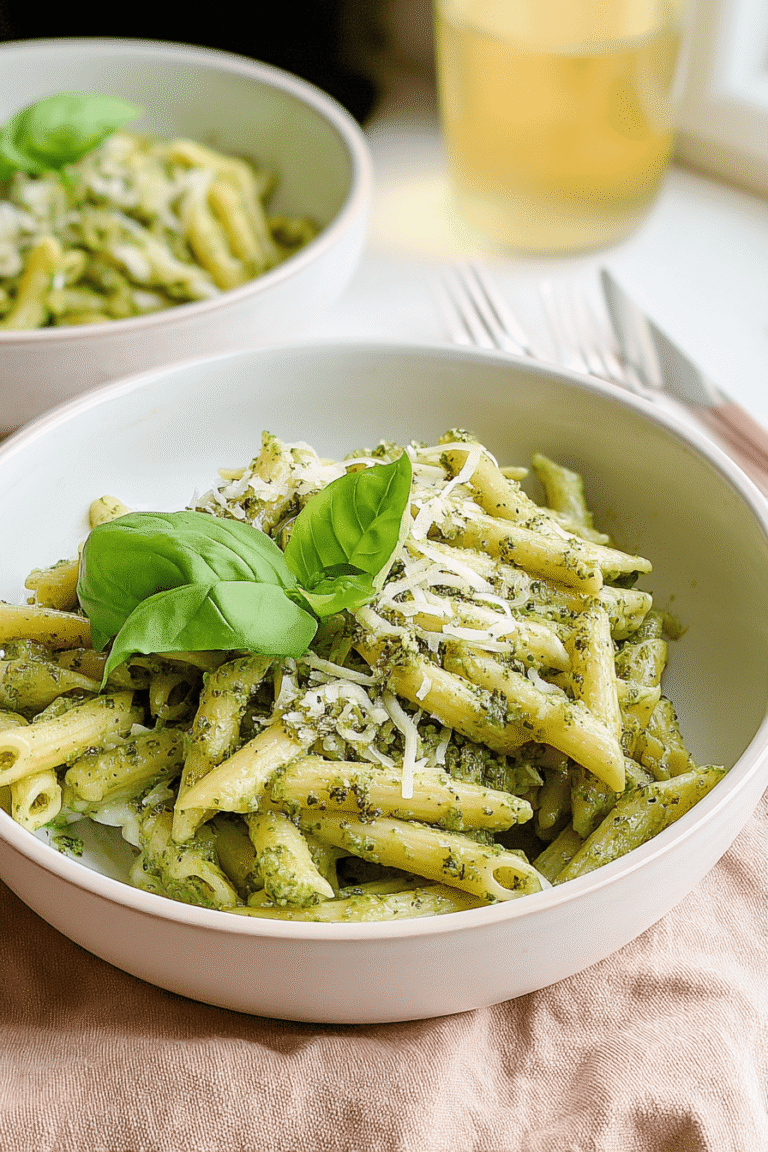Benefits and Advantages of zucchini pesto pasta
Zucchini pesto pasta offers a multitude of benefits that make it a standout dish for home cooks and food enthusiasts alike. One of its major advantages is the ease of preparation; this recipe requires minimal ingredients and simple steps that even beginners can master quickly. The use of fresh zucchini and homemade or high-quality pesto provides a flavorful yet light alternative to traditional pasta sauces, contributing to a refreshing dish that doesn’t compromise on taste.
From a nutrition standpoint, zucchini pesto pasta is a health-conscious choice, rich in vitamins, minerals, and antioxidants from the fresh vegetables and herbs. Additionally, this recipe lends itself well to various dietary preferences as it can be easily adapted to be vegan, gluten-free, and low-calorie, making it inclusive for different eating habits. Its versatility combined with wholesome ingredients makes zucchini pesto pasta a go-to meal that stands out not just for convenience but for sustaining a balanced diet.
The vibrant green hue and fragrant basil-infused pesto enhance the sensory experience, ensuring this dish is as pleasing to the eye as it is to the palate. In summary, the ease, health benefits, and unique flavor profile clearly distinguish zucchini pesto pasta as an exceptional recipe choice.
Jump to:
- Benefits and Advantages of zucchini pesto pasta
- Essential Ingredients for zucchini pesto pasta
- Dietary Substitutions to Customize Your zucchini pesto pasta
- How to Prepare the Perfect zucchini pesto pasta: Step-by-Step Guide
- Mastering zucchini pesto pasta: Advanced Tips and Variations
- How to Store zucchini pesto pasta: Best Practices
- Nutritional Value of zucchini pesto pasta
- FAQs: Frequently Asked Questions About zucchini pesto pasta
- What ingredients do I need to make zucchini pesto pasta?
- How can I make zucchini pesto pasta lower in carbs?
- What pasta shapes work best with zucchini pesto pasta?
- Can I use store-bought pesto for zucchini pesto pasta?
- What is the best way to reheat zucchini pesto pasta without losing flavor?
- Quick Creamy Zucchini Pesto Pasta Recipe for Busy Weeknights
- Ingredients
- Instructions
- Last Step:
- Notes
- Nutrition
- Did you make this recipe?
Essential Ingredients for zucchini pesto pasta
- 8 ounces dry pasta of choice (penne, casarecce, linguine, or similar)
- Salt for pasta cooking water
- 3 medium zucchinis (about 1 1/2 pounds), sliced into half-moons or shredded
- 2 tablespoons minced garlic (or 2 garlic cloves thinly sliced)
- 2 tablespoons olive oil (plus additional 3 to 5 tablespoons as needed)
- 2 tablespoons unsalted butter (optional, for added richness)
- Salt and freshly ground black pepper, to taste
- 1 cup basil pesto (homemade or store-bought)
- 1/2 to 1 cup reserved pasta cooking water
- 1/2 cup coarsely grated Parmesan cheese (or mixture of Parmesan and Pecorino), plus extra for serving
- Optional garnishes: roasted nuts (walnuts or pistachios, about 3 tablespoons), lemon zest (2 teaspoons) and juice (1 tablespoon), ricotta (1/4 cup whole milk), crushed red pepper flakes, sautéed mushrooms or shallots, burrata or mascarpone cheese
This combination ensures a delicious, balanced meal with fresh flavors and creamy textures, suitable for various diet preferences.

Dietary Substitutions to Customize Your zucchini pesto pasta
Customizing zucchini pesto pasta to meet dietary needs or ingredient availability is easy with these options:
- Vegan: Replace Parmesan cheese with nutritional yeast or vegan cheese and use plant-based butter alternatives.
- Nut allergies: Substitute pine nuts or walnuts in the pesto with seeds such as sunflower or pumpkin seeds for similar texture and flavor.
- Gluten-free: Select gluten-free pasta variants or substitute pasta with spiralized zucchini noodles to create a low-carb, gluten-free dish.
- Low-carb or ketogenic: Use spiralized zucchini noodles exclusively or reduce traditional pasta portions to lower carbohydrate content significantly.
- Herb alternatives: If fresh basil is unavailable, experiment with parsley, mint, or arugula in the pesto for different herbal notes.
These substitutions keep the dish accessible and flavorful, catering to varied dietary preferences without sacrificing taste or nutrition.

How to Prepare the Perfect zucchini pesto pasta: Step-by-Step Guide
- Prepare Zucchini: Wash and trim 3 medium zucchinis, then slice into half-moons or shred for richer caramelization and creamier texture. Squeeze out excess moisture if shredded to avoid watery sauce.
- Cook Pasta: Fill a large pot with water, add about 2 teaspoons salt, and bring to a boil. Add 8 ounces of pasta and cook until al dente according to package instructions (typically 17–20 minutes). Reserve 1/2 to 1 cup pasta cooking water before draining.
- Sauté Aromatics and Zucchini: Heat 2 tablespoons olive oil and optional 2 tablespoons butter in a large skillet over medium heat. Add minced or sliced garlic and sauté about 1 minute until fragrant but not browned.
- Cook Zucchini: Add sliced or shredded zucchini (and optional mushrooms or shallots) to the skillet. Season with salt and pepper and cook, stirring frequently, until tender and lightly caramelized (5–10 minutes).
- Prepare or Use Pesto: If preparing homemade pesto, blend fresh basil leaves, toasted nuts (walnuts or pistachios), Parmesan cheese, lemon zest and juice, garlic, salt, pepper, and olive oil until desired texture. Alternatively, use quality store-bought pesto.
- Combine Pesto with Vegetables: Stir pesto into the zucchini mixture, cooking for 1–2 minutes to meld flavors.
- Toss Pasta with Sauce: Add the drained pasta to the skillet and gently combine. Gradually add reserved pasta water as needed to loosen the sauce and coat pasta with a glossy finish.
- Finish and Serve: Toss in grated Parmesan cheese and optionally ricotta for creaminess. Adjust seasoning with salt, pepper, or lemon juice to taste. Serve hot garnished with extra Parmesan, toasted nuts, or other optional toppings.
This step-by-step guide ensures you prepare a flavorful, creamy zucchini pesto pasta that suits various dietary needs and yields consistent delicious results.
Mastering zucchini pesto pasta: Advanced Tips and Variations
To master zucchini pesto pasta, finely grate some zucchini in addition to spiralizing it; this creates additional texture and helps the sauce cling better to the pasta. Toast pine nuts or walnuts before adding them to the pesto to boost their nutty flavor and aroma. Try incorporating fresh herbs like mint or parsley alongside basil to give your pesto a fresh twist. For a richer sauce, blend in sun-dried tomato paste or roasted red peppers to introduce depth and color.
For a heartier meal, add grilled chicken, shrimp, or plant-based proteins such as tempeh to increase satiety. To keep it low-calorie, focus on spiralized zucchini noodles and limit olive oil usage. Finally, a squeeze of fresh lemon juice just before serving brightens flavors and adds a refreshing note, making your zucchini pesto pasta uniquely yours while retaining its fresh and healthy qualities.
How to Store zucchini pesto pasta: Best Practices
Proper storage of zucchini pesto pasta is key to maintaining its freshness and texture. Refrigerate leftovers within two hours of cooking in airtight containers, consuming them within 2 to 3 days. For longer storage, freeze the pesto sauce separately in freezer-safe portions (like ice cube trays) and blanch zucchini noodles briefly before freezing to preserve texture.
Reheat leftovers gently on the stovetop over medium heat or in the microwave, adding a splash of water or olive oil to keep the pasta moist and prevent drying. Avoid overheating to maintain the zucchini’s tender-crisp bite and the bright flavors of the pesto. Following these steps ensures your zucchini pesto pasta tastes as delicious reheated as when freshly made.
Nutritional Value of zucchini pesto pasta
| Nutrient | Typical Amount per Serving | Health Benefit |
|---|---|---|
| Calories | 300–400 kcal | Balanced energy from fats, proteins, and carbohydrates |
| Protein | 8–12 g | Supports muscle repair and provides satiety |
| Healthy Fats | 15–20 g (mostly unsaturated) | Promotes heart and brain health |
| Carbohydrates | Moderate (lower with zucchini noodles) | Source of steady energy |
| Vitamins A & C | Significant | Antioxidant support and boosts immune function |
| Minerals (Magnesium & Potassium) | Present | Supports metabolic functions and electrolyte balance |
This meal combines fresh vegetables and wholesome ingredients, making it a nourishing and well-rounded dish. For more on the Health Benefits of Zucchini and tips on How to Make Basil Pesto, check these resources.

FAQs: Frequently Asked Questions About zucchini pesto pasta
What ingredients do I need to make zucchini pesto pasta?
How can I make zucchini pesto pasta lower in carbs?
What pasta shapes work best with zucchini pesto pasta?
Can I use store-bought pesto for zucchini pesto pasta?
What is the best way to reheat zucchini pesto pasta without losing flavor?

Quick Creamy Zucchini Pesto Pasta Recipe for Busy Weeknights
🍝 Enjoy a Quick and Creamy Zucchini Pesto Pasta, perfect for busy weeknights when you need a delicious meal fast!
🌿 Loaded with fresh ingredients and bursting with flavor, this dish will satisfy your taste buds and give you more time to relax after dinner.
- Total Time: 35 minutes
- Yield: 6 servings 1x
Ingredients
8 ounces dry pasta of choice (such as penne, casarecce, linguine)
Salt for pasta cooking water
3 medium zucchinis
2 tablespoons minced garlic (or 2 garlic cloves thinly sliced)
2 tablespoons olive oil (plus additional 3 to 5 tablespoons divided as needed)
2 tablespoons unsalted butter (optional)
Salt and freshly ground black pepper, to taste
1 cup basil pesto (homemade or store-bought)
1/2 to 1 cup reserved pasta cooking water
1/2 cup coarsely grated Parmesan cheese (or a mixture of Parmesan and Pecorino)
Optional garnishes: roasted nuts, lemon zest and juice, ricotta, crushed red pepper flakes, sautéed mushrooms or shallots, burrata or mascarpone cheese
Instructions
1. Fill a large pot with water, add about 2 teaspoons salt, and bring to a boil.
2. Wash zucchinis, cut off the ends. Halve and slice into half-moons, or shred for more caramelization.
3. Cook pasta in boiling salted water until al dente, following package instructions. Reserve 1/2 to 1 cup of pasta cooking water before draining.
4. While pasta cooks, heat olive oil and butter in a large skillet over medium heat. Add garlic and sauté until fragrant.
5. Add zucchini, season with salt and pepper, and cook until tender and lightly caramelized. Add mushrooms and shallots if using.
6. Stir pesto into zucchini mix and cook for 1–2 minutes to meld flavors.
7. Add drained pasta to the skillet. Gradually add reserved pasta water to loosen sauce.
8. Toss in Parmesan cheese. Stir in ricotta if desired and adjust seasoning.
9. Serve hot, garnished with extra Parmesan cheese and optional toppings.
Last Step:
Please leave a rating and comment letting us know how you liked this recipe! This helps our business to thrive and continue providing free, high-quality recipes for you.Notes
🍋 Avoid overcooking zucchini to maintain a tender-crisp texture.
💧 Use pasta cooking water to achieve a silky, clingy sauce.
🥄 Customize with proteins like grilled chicken or shrimp.
- Prep Time: 10 minutes
- None: 0 minutes
- Cook Time: 25 minutes
- Category: Dinner
- Method: Stovetop
- Cuisine: Italian
- Diet: Vegetarian
Nutrition
- Serving Size: 1/6 of recipe
- Calories: 380–490
- Sugar: 3–4 g
- Sodium: 490–720 mg
- Fat: 27–29 g
- Saturated Fat: 5–6 g
- Unsaturated Fat: value unavailable
- Trans Fat: value unavailable
- Carbohydrates: 35–50 g
- Fiber: 16–18 g
- Protein: 13–14 g
- Cholesterol: value unavailable







